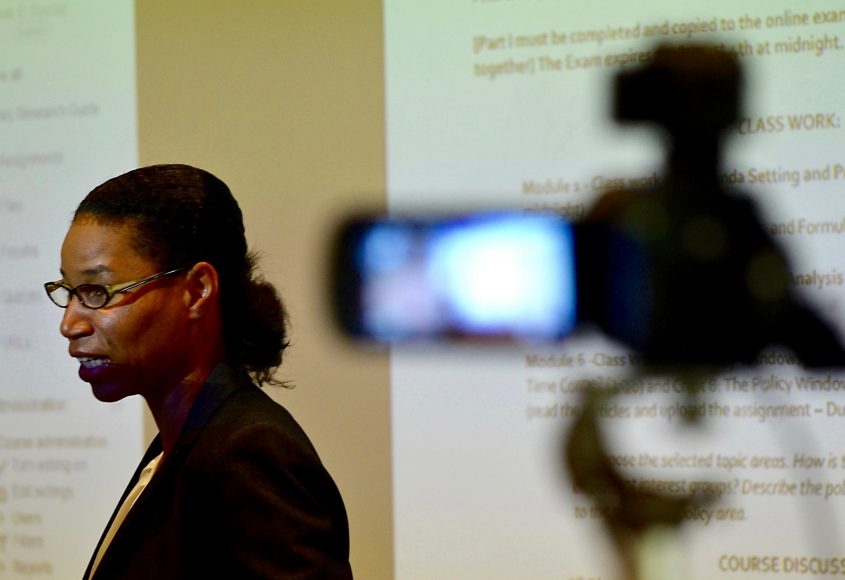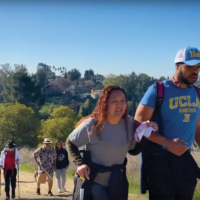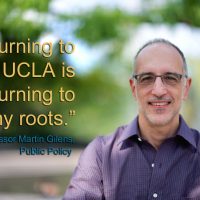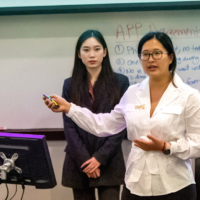
An Online Summer Gateway to a Public Policy Education In its second year, a web-based version of an introductory course allows UCLA students to get a headstart on a UCLA Luskin Public Affairs minor
By Stan Paul
Kenya Covington has been teaching Public Policy 10A at the UCLA Luskin School of Public Affairs for several years, so she’s well aware of the burdens for students who take the summer class.
Many students have very busy summer schedules “working with congressional members, doing summer internships or running youth mentoring camps,” she said, mentioning just a few of the typical commitments made by undergraduates at UCLA. “It dawned on me after the first summer teaching the course that the alternative online format might work well.”
Thanks to Covington, undergrads who are pursuing a minor in public affairs at UCLA Luskin can take the core introductory course online. Public Policy 10A has served as the gateway for the public affairs minor since shortly after the Luskin School was established more than 20 years ago. Now in its second online summer run, the course is a welcome addition — judging from the impressive summer enrollment of nearly 80 students.
But, despite the convenience, the six-week summer course is no “lite” version of the course offered during the regular academic year, said Covington, who’s also a new member of the UCLA Luskin Public Policy faculty. Covington said that, even though the course is online, it will remain rigorous and true to the in-class version she has taught two previous summers at Luskin.

Kenya Covington speaks to students during the Public Policy 10A class taping. Photo by Stan Paul
It was Covington who brought 10A online last summer with an initial enrollment of 35 students. Covington, who has previous online instruction experience at California State University Northridge (CSUN), said her goal was to create a flexible course that “students can take with them on the road.”
“This course is fast-paced,” Covington said. “Students must stay on top of the work … there are quite a few tasks to be completed for every weekly module.” She said that self-directed learners will succeed in the course.
Like the in-class version, the course is chock full of reading from an assigned text and other materials, as well as additional video content on topics and tools used in policy analysis. These include policy memo-writing and cost-benefit analysis — the same skills honed by the school’s master of public policy (MPP) students.
Covington noted that a great deal of effort is required to ensure the quality of the course. “I work to duplicate the course quality of the face-to-face traditional course,” she said. “Student learning objectives are linked to the lectures that are posted online and to classwork assignments that are embedded in weekly modules.”
Covington’s areas of study include the examination of social and economic inequality associated with the structural makeup of metropolitan areas. At UCLA Luskin, she teaches courses on housing policy, research methods, urbanization, social inequality and urban poverty.
For students more accustomed to a classroom setting, Covington provides a number of optional live sessions. Those classes are recorded and serve as supplementary online content for future presentations of the course.
Among the students who enjoy the face-to-face experience with the convenience of online learning is UCLA senior Bryan Dean, who is juggling an internship this summer with studying for the GRE, the graduate record examination.
“This is not my first online course, but it is my first online course at UCLA.,” said Dean, who hopes to pursue graduate studies in public policy. “I really enjoy the course format with the mixture of in-class meetings and online materials.”

Venette Agustin was among the UCLA undergraduate students attending the optional in-person class that was recorded for the Public Policy 10A course. Photo by Stan Paul
Online content isn’t a new concept at UCLA. All courses have an interactive class web page and built-in aspects of a “blended course.” Students who grew up with smart phones, tablets and the internet are accustomed to finding their course syllabi online as well as turning in assignments online and having access to downloadable supplementary materials, internet links to readings and more.
Covington requires students to participate in an open forum during which the class discusses a topic linked to the focus of the weekly modules. Students are required not only to submit posts, but must comment on other students’ posts, which adds a social and participatory element to the course.
In her in-class introductory session this summer, Covington urged students to stay connected. “The challenge with the online is you don’t get to interface with me as much, so you don’t get to pick my brain as easily about things that you are interested in. But don’t hesitate, send me an email,” she said.
Non-traditional students — those who are typically working full- or part-time jobs while going to school — may find this type of course more appealing. “These courses allow them to pursue their academic goals,” Covington said. “The value of online is that it provides maximum flexibility for students.”








Leave a Reply
Want to join the discussion?Feel free to contribute!